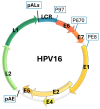HPV Infections-Classification, Pathogenesis, and Potential New Therapies
- PMID: 39062859
- PMCID: PMC11277246
- DOI: 10.3390/ijms25147616
HPV Infections-Classification, Pathogenesis, and Potential New Therapies
Abstract
To date, more than 400 types of human papillomavirus (HPV) have been identified. Despite the creation of effective prophylactic vaccines against the most common genital HPVs, the viruses remain among the most prevalent pathogens found in humans. According to WHO data, they are the cause of 5% of all cancers. Even more frequent are persistent and recurrent benign lesions such as genital and common warts. HPVs are resistant to many disinfectants and relatively unsusceptible to external conditions. There is still no drug available to inhibit viral replication, and treatment is based on removing lesions or stimulating the host immune system. This paper presents the systematics of HPV and the differences in HPV structure between different genetic types, lineages, and sublineages, based on the literature and GenBank data. We also present the pathogenesis of diseases caused by HPV, with a special focus on the role played by E6, E7, and other viral proteins in the development of benign and cancerous lesions. We discuss further prospects for the treatment of HPV infections, including, among others, substances that block the entry of HPV into cells, inhibitors of viral early proteins, and some substances of plant origin that inhibit viral replication, as well as new possibilities for therapeutic vaccines.
Keywords: HPV; pathogenesis; pharmacological therapy; systematics; vaccines.
Conflict of interest statement
The authors declare no conflicts of interest.
Figures
Similar articles
-
Advances in Designing and Developing Vaccines, Drugs and Therapeutic Approaches to Counter Human Papilloma Virus.Front Immunol. 2018 Nov 12;9:2478. doi: 10.3389/fimmu.2018.02478. eCollection 2018. Front Immunol. 2018. PMID: 30483247 Free PMC article. Review.
-
The human papillomavirus replication cycle, and its links to cancer progression: a comprehensive review.Clin Sci (Lond). 2017 Aug 10;131(17):2201-2221. doi: 10.1042/CS20160786. Print 2017 Sep 1. Clin Sci (Lond). 2017. PMID: 28798073 Review.
-
Targeting human papillomavirus genome replication for antiviral drug discovery.Antivir Ther. 2013;18(3):271-83. doi: 10.3851/IMP2612. Epub 2013 Apr 24. Antivir Ther. 2013. PMID: 23615820 Free PMC article. Review.
-
Genital human papillomavirus infections: current and prospective therapies.J Gen Virol. 2012 Apr;93(Pt 4):681-691. doi: 10.1099/vir.0.039677-0. Epub 2012 Feb 8. J Gen Virol. 2012. PMID: 22323530 Review.
-
The Use of Both Therapeutic and Prophylactic Vaccines in the Therapy of Papillomavirus Disease.Front Immunol. 2020 Feb 18;11:188. doi: 10.3389/fimmu.2020.00188. eCollection 2020. Front Immunol. 2020. PMID: 32133000 Free PMC article. Review.
Cited by
-
Prevalence and Genotypic Diversity of High-Risk Human Papillomavirus Among Women of Reproductive Age in Kilifi County, Kenya.Cureus. 2025 Apr 29;17(4):e83191. doi: 10.7759/cureus.83191. eCollection 2025 Apr. Cureus. 2025. PMID: 40443628 Free PMC article.
-
Unveiling the Mechanism of Retinoic Acid Therapy for Cutaneous Warts: Insights from Multi-Omics Integration.Clin Cosmet Investig Dermatol. 2024 Dec 18;17:2923-2932. doi: 10.2147/CCID.S504391. eCollection 2024. Clin Cosmet Investig Dermatol. 2024. PMID: 39712939 Free PMC article.
-
HIV-HPV Co-Infection and Identification of Novel High-Risk HPV Among Women at Two Hospital Centers in Cotonou, Republic of Benin.Viruses. 2025 May 16;17(5):714. doi: 10.3390/v17050714. Viruses. 2025. PMID: 40431725 Free PMC article.
-
The Effectiveness of Topical Treatment for Plantar Warts: A Retrospective Cohort Study.Infect Dis Rep. 2024 Nov 26;16(6):1108-1117. doi: 10.3390/idr16060090. Infect Dis Rep. 2024. PMID: 39728012 Free PMC article.
-
Clinicopathological Findings and Comprehensive Review of Buschke-Lowenstein Tumors Based on a Case Study.J Pers Med. 2024 Aug 22;14(8):887. doi: 10.3390/jpm14080887. J Pers Med. 2024. PMID: 39202078 Free PMC article.
References
-
- Bruni L., Albero G., Serrano B., Mena M., Collado J.J., Gómez D., Muñoz J., Bosch F.X., de Sanjosé S., ICO/IARC Information Centre on HPV and Cancer (HPV Information Centre) Human Papillomavirus and Related Diseases in the World. Summary Report. Mar 10, 2023.
-
- [(accessed on 19 April 2024)]. Available online: https://www.who.int/news-room/fact-sheets/detail/human-papilloma-virus-a....
Publication types
MeSH terms
Substances
LinkOut - more resources
Full Text Sources



